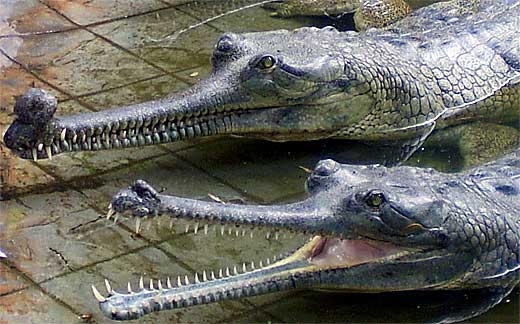Gavial, Gharial, the Fish-Eating Crocodile

Slender Snouted Gavial
The fish-eating crocodile, is also known as the gharial or gavial. It is a less famous member of the crocodile family whose numbers have been declining and is now an endangered species. It is easily distinguishable from the other family members because of its long, slender snout and narrow, sharp teeth. It is large, with the average length being 13-20 ft (4-6 m). The color ranges from olive green to brown-gray with a light underside. Males have a growth of tissue like a knob on their noses. This tissue is shaped like a clay jar made by natives of India, known as a “ghara”, this is reputed to be the origin of their name. They can also use this knob to make a loud buzz to scare away would-be enemies. The jaw of gavial is not particularly powerful like that of its cousins. That, along with its odd feeding habits, distinguishes it from the other crocodiles.
They feed primarily on small fish, only occasionally supplemented by birds, dogs, or goats. This species rarely attacks humans but with those teeth you don’t want to be too close.
The preferred habitat of the gharial is high-banked rivers with clear, fast-flowing water and deep pools. It is claimed that they spend more time in the water than other crocodiles.
They reach maturity at 8-12 years. Females make nests in the sand banks and guard the eggs for 83-94 days. Eggs and hatchlings are threatened by a variety of predators, so the female guards the nest and tends the hatchlings for a period of several months.
Habitat and Current Distribution
The gharial is currently known to exist only in India and Nepal. The species is regarded as extinct in Myanmar, and thought to be extinct in Bangladesh, Bhutan, and Pakistan, although there are occasional sightings, or alleged sightings in some of these locations. It is classified as critically endangered in India and Nepal. The total worldwide population in 2006 was estimated to consist of fewer than 200 animals in India and fewer than 35 in Nepal. These numbers represent a decrease of about 96 percent from population numbers for the 1940s. As of 2006, only three breeding sites for the species were known. The largest is in the Chambal Wildlife Sanctuary in India, with 68 nests. The other two sites are located in the Katerniaghat Wildlife Sanctuary (20 sites) and the Son River Sanctuary (two nests), both also in India.
History and Conservation Measures
While the gharial was common in many areas in the 19th and early 20th centuries, its numbers have since been severely reduced. The decline is attributed primarily to loss of habitat, hunting for its skin, and accidental killing in the course of fishing operations. An additional concern is the practice of egg collecting by tribal groups, but this practice would probably not constitute a threat if populations were at higher levels.
The fast-flowing rivers favored by the gharial are prime sites for the construction of dams and reservoirs used by hydroelectric facilities or irrigation projects. Construction of a dam typically eliminates sandbanks and deep pools both upstream and downstream of the site, thus destroying the gharial’s preferred habitat. This practice, in conjunction with commercial hunting of the species for hides, has decimated its population. Hunting has declined following legislative protection and the scarcity of the species has made hunting less common. There have been some attempts in India, Nepal and Pakistan to release captive-bred young into protected habitats.
